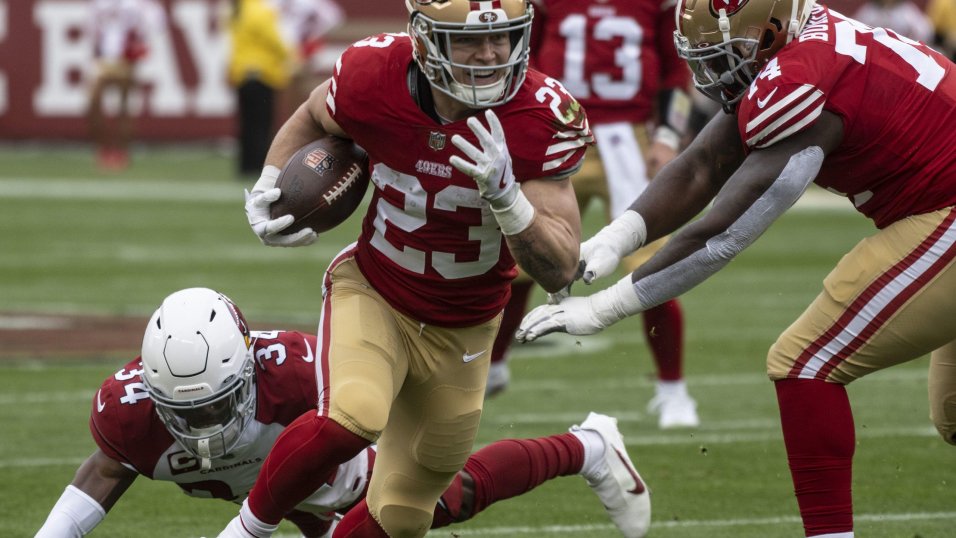image caption
Chasing History: Rams' Nacua on Verge of Setting More Rookie Records
The Rams' rookie can break two single-season records Sunday, including one that's lasted 63 years.
Now that the Los Angeles Rams have qualified for the playoffs, coach Sean McVay will rest many of his starters for Sunday's regular-season finale vs. San Francisco. However, wide receiver Puka Nacua won't be one of them, and there's a reason.
He's this close to setting two rookie records.
The Rams' fifth-round draft pick needs 29 receiving yards to set one single-season mark and just four catches to break another, Jaylen Waddle's rookie record of 104. So, he'll play Sunday, though it's not known how much.
"I think you’d like to be able to see him get an opportunity to do something special," McVay said, "and then be smart with him."
Waddle's record was set in 2021, but the rookie yardage mark has lasted 63 years. Set in 1960 by former Houston Oilers' split end Bill Groman when he reached 1,473 yards, it is -- as McVay said -- "something special." So, if and when Nacua breaks those records, he moves to the head of the line ... right?
Yes. And No.
According to the NFL he will. It recognizes records by season, regardless of length. But fairness demands that when considering single-season records, we also consider the number of games it took to set them. At 17 games, today's NFL seasons are longer than those of previous eras, giving recent players like Nacua a significant advantage over someone like Groman.
When he set the mark in his rookie season, he did it in 14 games -- the length of the AFL season then. But if he had the opportunity to play three more games, who knows what the mark would have been -- 1,600? Maybe 1,700? Given that, shouldn't the record remain with the former All-AFL performer?
Perhaps.
Like Nacua, Groman wasn't someone expected to explode as a rookie. He played collegiately at Heidelberg College (Ohio) and drew no attention from NFL teams. So he spent his first years after college teaching eighth-graders before he was encouraged to try out for the newly-formed American Football League.
He not only made the Houston Oilers; he became a starter. And the rest is history. Literally.
In his first season, Groman caught 72 passes, scored 12 touchdowns and had an AFL-best 20.5 yards per catch. He led the league again in 1961 with a 23.5 yards per catch on 50 receptions (his yardage total was 1,175) and an AFL-high 17 touchdown catches.
But things went south the following season. Bothered by a knee injury sustained in the 1961 championship game, Groman was so ineffective that new Oilers' coach Pop Ivy -- convinced that Groman couldn't perform as he had the previous two years -- waived him at midseason.
When Oilers' fans protested, the team backed down. It recalled Groman from the waiver wire (as it was allowed) and kept him that year. But he didn't get his job back, was traded to Denver where he wasn't effective and completed his career with a couple of seasons as a backup with the Buffalo Bills.
Groman later went on to become a scout with various pro football organizations, spending his last 15 years with the Atlanta Falcons. It was there that he crossed paths with a young scout named Les Snead -- the same man who chose Nacua in the 2023 NFL draft.
Now there's another parallel that links Nacua and Groman: Just as Nacua could make history by breaking records with extra games, so did Groman.
The mark he broke in 1960 was set by Green Bay rookie Billy Howton in 1952 ... when the NFL played 12-game seasons. A second-round pick that year, Howton led the NFL with 1,231 receiving yards. However, Howton's yards-per-scheduled games were 102.6. Groman's were 105.2.
Wait. Yards-per-scheduled games? It's a figure reached by dividing total receiving yards by the number of games on the NFL schedule, a metric first suggested by Pro Football Researcher Association founder Bob Carroll. He saw it as a fairer way to measure single-season records, no matter the category -- receiving, rushing, passing, etc.
there is more ....click link to read all of it


